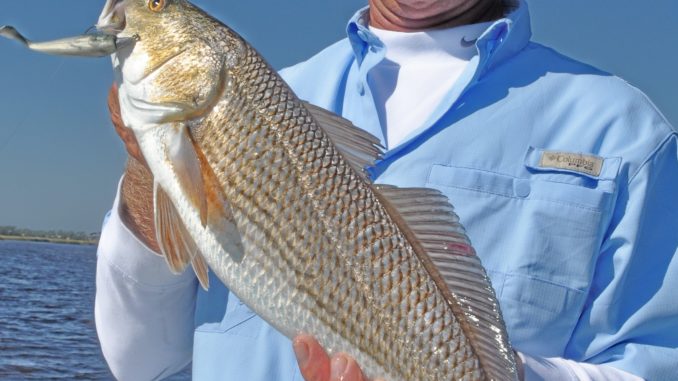
Heat doesn’t stop central coast drum
August usually is boiler-room hot across North Carolina, especially along the coasts. Many fishermen pass up high temperatures and off-the-chart humidity for air-conditioning, cool drinks and the Golf Channel.
But those who don’t mind the heat may challenge inshore red drum and have productive trips, especially during early-morning and late-evening hours.
I’m going for red drum mostly in August,” said guide Dale Collins of Bait Runner Charters in Stella (252-422-4326), “but flounder also usually move to the oyster beds in creek mouths during August.”
The best times to fish “are really early and late,” said Collins, who concentrates on the area from Emerald Isle south several miles. “That’s when you’re likely to get a topwater bite for red drum. I go for them first; then we’ll try flounder. That’s because reds hit topwater lures best when you start the day before the sun gets high.”
Red drum disperse in bays and inside creeks during summer after being together mostly during the winter and spring.
“But they go to the same places and will stay there unless they get disturbed,” Collins said. “Reds stay in the same bays in almost the same spots unless something runs them off, and they travel the same grass banks.”
However, redfish won’t totally scatter in summer.
“You might find five to 15 reds along a marsh bank or in a creek,” he said. “Sometimes they’ll be near an oyster bed that’s uncovered during low tide; when it’s high tide, they’ll be right on top of it, feeding for little black crabs that live between oyster shells.”
If red drum don’t seem to be interested in soft-plastic lures, such as 3- to 5-inch paddletails or Flukes threaded onto 1/8- to 1/4-ounce jighead hooks or plastic crabs, they’ll hit Carolina-rigged mud minnows or blue crabs chunks.
Sometimes, Collins puts soft-plastic lures beneath popping corks with a 4-foot leader or a circle hook to lip-hook live finger mullet, crab chunks or mullet chunks.
He keeps legal-size blue crabs (at least 5 inches wide), pops off the shell, cuts off the legs, quarters the crab body and hooks them on Carolina rigs with circle hooks.
“We pulled into another bay, I put out the first crab, and a red nearly jerked the rod out of my hand,” Collins said. “From that point, they caught reds on blue crab pieces until they were worn out.”
He uses 7-foot medium, medium-light or medium-heavy Star Seagis rods mated to Penn 2500, 3000 or 4000 Series reels.
“I fish from Emerald Isle to Browns Inlet, depending where I know reds are likely at,” Collins said.


Be the first to comment